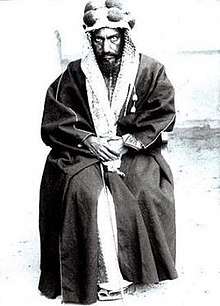Abdul Rahman bin Faisal
Abdul Rahman bin Faisal Al Saud (1845–1928)[1] (Arabic: عبد الرحمن بن فيصل آل سعود / ALA-LC: ‘Abd ar Raḥman bin Fayṣal) was the last ruler of the Emirate of Nejd, the second Saudi state. He was the youngest son of Faisal bin Turki bin Abdullah Al Saud and the father of Ibn Saud, who founded the modern Saudi Arabia.
| Abdul Rahman bin Faisal | |||||
|---|---|---|---|---|---|
 | |||||
| Emir of Nejd | |||||
| Reign | 1875–1876 (first time) 1889–1891 (second time) | ||||
| Predecessor | Saud bin Faisal bin Turki Abdallah ibn Faisal ibn Turki | ||||
| Successor | Muḥammad (I) bin ʿAbdullah Al Rashid | ||||
| Born | 1845 | ||||
| Died | 1928 (aged 82–83) Riyadh, Kingdom of Hejaz and Nejd | ||||
| Issue |
| ||||
| |||||
| Dynasty | House of Saud | ||||
| Father | Faisal bin Turki bin Abdullah Al Saud | ||||
Royal Civil War
When Abdul Rahman's brothers — Saud and Abdullah — were struggling for power in 1865,[2] Abdul Rahman and his brother Muhammad tended to align themselves with Saud. In 1871, after Saud had taken the capital Riyadh. Abdul Rahman was sent to Baghdad to negotiate with the Ottoman Empire for help. Unsuccessful after two years, he tried to take Al-Hasa in the east where Abdullah was now based, but without success, and eventually returned to Riyadh. After Saud's death in 1875, Abdul Rahman was recognized as successor, but within a year Riyadh was taken by Abdullah. He was forced to abdicate.
In 1887 the sons of Saud bin Faisal, who kept up desultory hostilities against their uncles, managed to capture Abdullah. The Rashidi amirs of Ha'il were able to secure Abdullah's release in exchange for Abdul-Rahman. Abdullah was taken to Ha'il and a Rashidi emir appointed to him to govern Riyadh. Abdul Rahman was able to rise in revolt in 1887 and take and defend Riyadh, but his attempts to expand control ended in disaster. When Abdul Rahman became the undisputed leader of the House of Saud in 1889, he attacked and regained Riyadh.[2] However, the Saudi forces were defeated in the Battle of Mulayda, and Abdul Rahman and his family were forced to flee.[2]
Later years and death
The family fled to the desert of the Rub al-Khali to the southeast among the Al Murrah Bedouin, before finding refuge with the Al Khalifa family in Bahrain, and finally with the Al Sabah family in Kuwait.[2] They were given permission by the Ottoman State to settle in Kuwait.[3] While in Kuwait, Abdul Rahman tried to make Wahhabist Islam widespread and recreate the Saudi Dynasty.[4]
After defeat at the battle of Sarif in 1900, he gave up all ambitions to recovery his patrimony.[1] Following the capture of Riyadh by his son, Abdulaziz, in January 1902 he came back from Kuwait and presented his son a sword that had belonged to Muhammad ibn ‘Abd al Wahhab.[5] Abdul Rahman was styled Imam and considered the spiritual leader of the country, while Abdulaziz held secular and military authority. He also acted as the ceremonial leader of the newly built state.[5] He died in Riyadh in 1928.[6][7]
References
- Philby, H. St. John (1955). Saʻudi Arabia. London: Ernest Benn. p. 236. OCLC 781827671.
- "Abdul Rahman bin Faisal Al Saud (1)". King Abdulaziz Information Source. Archived from the original on 21 February 2014. Retrieved 9 August 2012.
- Joel Carmichael (July 1942). "Prince of Arabs". Foreign Affairs. Retrieved 7 August 2020.
- Czerniawski, Maxvell (2010). Blood in the Wells: The Troubled Past and Perilous Future of US-Saudi Relations (Senior Honors Thesis). Eastern Michigan University. Retrieved 2 May 2012.
- "FDR and Ibn Saud, 1744 to 1953". Ibn Saud (PDF). Brookings Institute. 2017.
- Abdullah F. Alrebh (September 2015). "Covering the Building of a Kingdom: The Saudi Arabian Authority in The London Times and The New York Times, 1901–1932". DOMES: Digest of Middle East Studies. Retrieved 29 June 2020.
- "Appendix A Chronology of the Life of Ibn Saud" (PDF). Springer: 197. Retrieved 5 August 2020.
| Regnal titles | ||
|---|---|---|
| Preceded by Saud bin Faisal bin Turki |
Emir of Nejd 1875–1876 |
Succeeded by Abdallah ibn Faisal ibn Turki |
| Preceded by Abdallah ibn Faisal ibn Turki |
Emir of Nejd 1889–1891 |
Succeeded by The Rashids of Hail |
| Preceded by Faisal bin Turki |
Head of the House of Saud 1889–1901 |
Succeeded by Abdul-Aziz bin Abdul Rahman Al Saud |